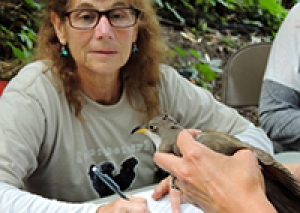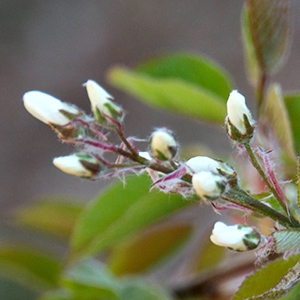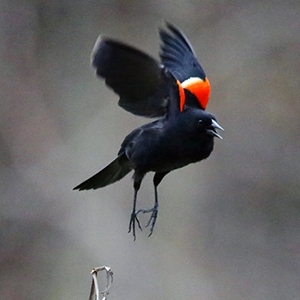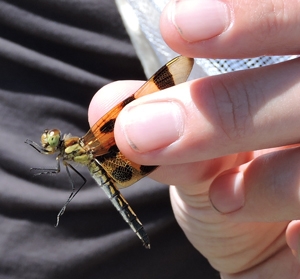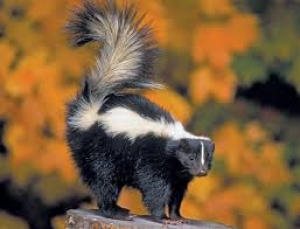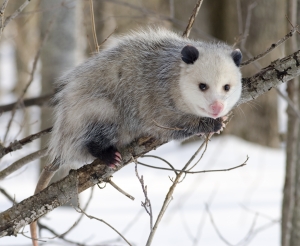
Join our Research (and Storytelling) Team!
A good researcher performs many roles — observer, record keeper, historian and the like. But one of our favorites is storyteller. You may have heard about how the UEC heals the land through thousands of hours from land stewardship volunteers and staff pulling nonnative plants, planting natives and preventing erosion. Often the results of these efforts are easy to see.
Community Science
The Urban Ecology Center's Community Science Program serves as a meaningful bridge between academic research and the community-at-large. The program creates collaborative spaces for research between professional and community scientists and creates a more engaged, knowledgeable and ecologically literate community. The Center maintains a network of urban field stations in which all research is accessible to and advised by both community and professional researchers.
Community members conduct cutting-edge research, from studying the physiology and phenology of migrating birds to discovering the winter quarters of threatened snakes. Community Scientists monitor and research bats, bugs, plants, snakes, turtles, mice, people and a host of other critters!
Support monitoring and research efforts on the unique plants and animals within our parks.

Learn how we study snakes, birds, and other animals living in the greenspaces we manage
False Spring: How Plants React to Unseasonal Warmth
Coming from the perspective of a human (a true biological juggernaut of adaptability), the past couple of weeks have been a real joy. For a few glorious days, I wore a tank top outside at work (in February!) and today I’m walking in a winter wonderland again. While the particular weather pattern we’ve just experienced here in Milwaukee has been a treat for us humans, for the plants around us, trees and shrubs especially, it will prove to be more of a trial.
Red Wings and Early Spring
For those of you who may not know, we have an organization-wide phenology competition every year to document the first of year (FoY) Red-winged Blackbird, Eastern Chipmunk, Mourning Cloak, and Butler's Gartersnake. The documentation of these four species typically signifies the arrival of spring and the dismissal of winter. This year's unseasonal warm weather, however, has a resulted in an uncomfortably early kickoff.
CRIKT and You
It is the season of showy butterflies, buzzing cicadas, crackling grass hopper wings and CRIKT research. Nope, that is not a typo. CRIKT stands for “Citizens Researching Invertebrate Kritters Together” and this research team at the Urban Ecology Center is leading the nation in its approach to field ecological research. “Invertebrate Kritters” refers to the vast array of animals found in the insect, spider and mite categories. Because invertebrates impact people in a variety of ways: pollinating crops, decimating crops and invoking some of our greatest fears or senses of awe, they have been studied quite a bit over the years. So what sets CRIKT apart? It is WHO is involved and WHERE they work.
Native Animal: Striped Skunk (Mephitis mephitis)
A potent odor in Three Bridges Park recently led us to a dead skunk lying next to the Menomonee River. It rested, amazingly intact, on a sewerage outflow pipe lightly covered in snow. Whether he was the victim of hypothermia, winter starvation or a ravenous hawk remained a mystery, but whatever the skunk’s demise, it was clear that two weeks after he had perished, his scent still lingered.
Native Animal of the Month: Eastern Screech Owl
Last fall at Riverside Park, the research and community science department was hosting the Wisconsin DNR’s bat biologists for an evening of bat mist netting, when a gregarious little screech owl paid us a visit. As DNR biologist Paul White held the large group of participants enraptured with a live bat, a persistent whinny in the distance distracted those of us at the back of the group.
Native Animal: Opossum (Didelphis virginiana)
When I think of the opossum, I think of a scrappy little character; tough, resilient, clever, and tenacious. In fact, one of my first memories of the opossum demonstrates its impressive adaptability. When tree hollows and brush piles provided inadequate shelter, the resourceful opossum sought shelter elsewhere - she would sneak in under our house's raised foundation and hunker down next to the hot water pipes beneath the bathrooms. There, she would build a comfortable bed of dry grass and stay till spring. And sometimes, when my family would take a shower or bath, you could even hear the scratching of little opossum paws against the water pipes, presumably acknowledging the relief provided by the warm plumbing.
Native Animal of the Month: Beaver (Castor canadensis) Part 2
By now you have probably heard about the Riverside Park Beaver. He’s been chewing down Milwaukee River Greenway trees since the summer of 2014, has been featured on local news segments, has been written about in social media and blog articles, and even became the star of our recent Earth Month grant-matching campaign. But, how much do you really know about this busy beaver? You might be surprised to learn that this species is much more complex than one might think.
Green Birding Challenge Recap
Thank you to everyone who helped make the 5th Annual Green Birding Challenge a success! 19 teams, comprised of both experienced and fledgling birders, participated in this year's challenge and observed over 100 distinct bird species in a fossil fuel free search around the city. Their efforts inspried more than 150 generous donors to pledge $8,000 for the Center's Citzien Science program. Wow! Read on for more fun facts and photos from the day's birding adventure!
Copyright © 2023 The Urban Ecology Center

